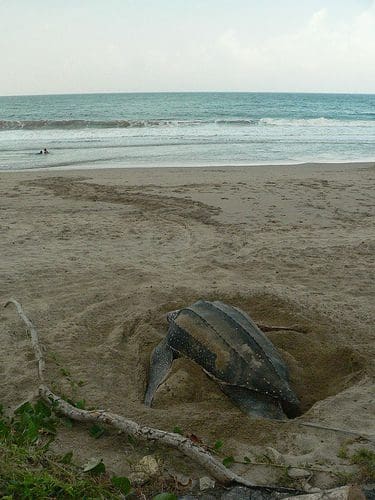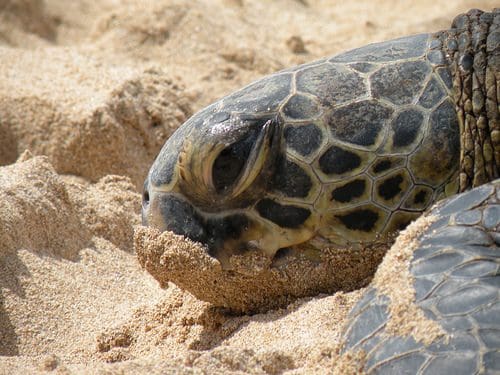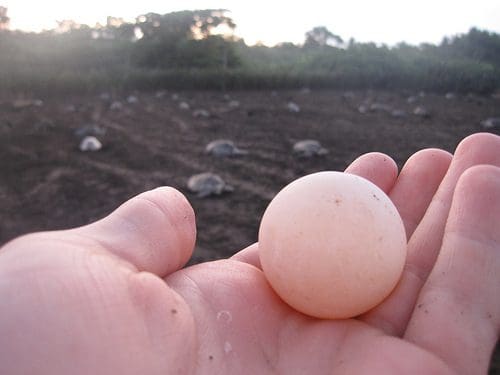Sea Turtle populations worldwide have dramatically declined over the last century due to poachers who harvest turtle meat, eggs and shells to sell for consumption and souvenirs. While conservationists have brought attention to the dire circumstances of some species and the importance protecting these marine reptiles, the endangered status continues. Less sinister than poachers, but still with significant impact, is traditional drift net fishing that inadvertently catches and kills adult sea turtles.

Viewing the nesting grounds is a spellbinding experience as the large female comes ashore, painstakingly prepares her nest and lays her eggs. This activity is done at night and at dawn, she returns to the sea. In about 2 months, dozens of hatchlings toddle to the sea, although it is estimated that only about one in 1,000 survive.
In addition to a high death rate, sea turtles mature very slowly; some species are 40-50 years old before they mate and reproduce. Beach development and human encroachment on nesting grounds has reduced populations over the last 30 years, as has global warming. Warmer water affects the reefs that turtles feed from and rising seas engulf nesting beaches. Sea turtles also have the unique characteristic that the gender is determined by the temperature of the egg during incubation. A slight rise in beach temperature results in almost all female populations, which has obvious consequences on future reproduction. All of these factors make these giant marine reptiles’ future existence very precarious.
Some facts about the sea turtles of Costa Rica:

The Leatherback –
- The largest living reptile – up to 9 feet and 1900 pounds!
- Food – jellyfish and other gelatinous organisms.
- Nesting – September to March on the Pacific side, February to July on the Atlantic side of Costa Rica. Up to four times a season, she digs a deep hole in the sand and lays 45-100 eggs in a clutch (nest).
- Critically Endangered status – estimated less than 25,000 in the world, one fifth of 1980 population.
The Hawksbill –
- Small to medium-sized – 25-35 inches, 100-150 pounds.
- Food – Beak like mouth gives it the name allows it to reach into holes in coral reefs for marine sponges.
- Nesting – Returns to natal beach (birthplace) every 2-3 years, nests 3-5 times per season, 130 eggs each. Builds nests high up on beach in little to no sand.
- Protected status – Threatened by loss of coral reef (food source) and commercial exploitation of its shell.
The Pacific Green –
- Largest of the hard shell sea turtles – up to 3 feet and 350 pounds
- Food – Herbivore (seagrass and algae).
- Nesting – June to September but varies by location, returns to natal beach every 2-4 years, nest every 2 weeks on average 5 times in a season, lays 135 eggs per clutch. One of the largest nesting populations is at Tortuguero, on the Caribbean coast of Costa Rica.
- Endangered status – threatened by harvest of eggs and capture of adults.

The Olive Ridley –
- Relatively small – 22-31 inches and up to 100 pounds
- Food – Omnivorous (shrimp, crustaceans), highly migratory
- Nesting – Arribada occurs June to December on certain beaches. Females gather offshore of nesting beach and thousands come ashore at same time to dig nests.
- Protected status – Most abundant sea turtle in the world, many populations not depleted.
Visitors to Costa Rica can help with the conservation of these endangered creatures. In addition to learning about their plight, it is most important to never purchase any turtle product or support the illegal poachers in any way. There are many volunteer opportunities to assist with turtle conservation efforts in Costa Rica as well. Covington advisors can help you plan a trip that includes seeing turtles nest or helping with conservation efforts. If you have seen or worked with the turtles in Costa Rica, please share your story in the comments below.






For those looking to see sea turtles in Costa Rica, there’s a list of nesting times and places which should help trip planning – http://itravel-costarica.com/seaturtles.php.
Volunteering while on vacation in Costa Rica might also be appealing to people.
Lisa – Thanks for sharing this great info! Cheers – Beverly